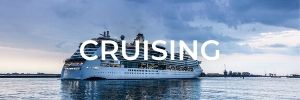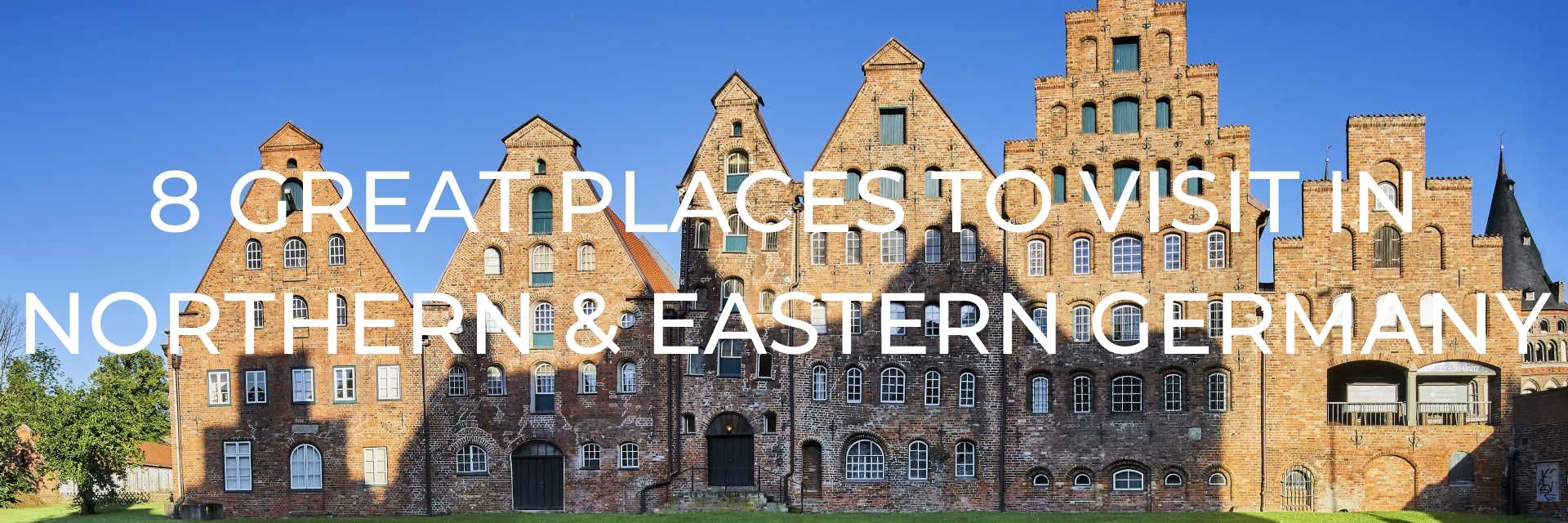
From seaside resorts with beautiful white sand beaches to modern, bustling cities full of rich history – a visit to Northern and Eastern Germany offers visitors looking for diversity all of this and much more.
The scenery of Northern Germany is a landscape of rich farmland fed by canals and rivers, expanses of moorland and heathery heath. Along the coast of the Baltic Sea you’ll find plenty of water and beaches, but not too many people if you’re looking for a quieter holiday. Or take a visit to one of its Hanseatic towns that represent its sea faring traditions with pretty old buildings built with iconic black and white bricks.
Eastern Germany offers visitors a seemingly endless array of art, and architecture in its cities with ancient palaces, soaring church towers, and medieval fortifications. And, of course, the capital city of Berlin is a must-do as the cultural hub of Germany bursting with history.
Want to save this for later? Click the Pinterest button on the left for a pinnable image!

Whether you’re visiting for a weekend, a week … or longer, here are eight great places to visit in Northern and Eastern Germany to experience the best the region has to offer as recommended by fellow travel bloggers and us.
AHLBECK
Ahlbeck, a German district on the island of Usedom which is quaintly shared by both Poland and Germany, lies in the easternmost portion of the Kaiserbäder, a long line of seaside resorts that were once frequented by the German emperor Wilhelm II before 1918. Bordering Poland’s side of the island, Ahlbeck provides the perfect base to explore either side of Usedom and witness the intermingling of Polish and German culture. It is here that you will literally get the best of both worlds.
Not just a spa town, Ahlbeck’s gardens and nature parks provide stunning settings for strolls, bike rides, and picnics. The perfect location for family fun and intimate escapes, the island of Usedom has plenty of scenic and romantic spots to offer.
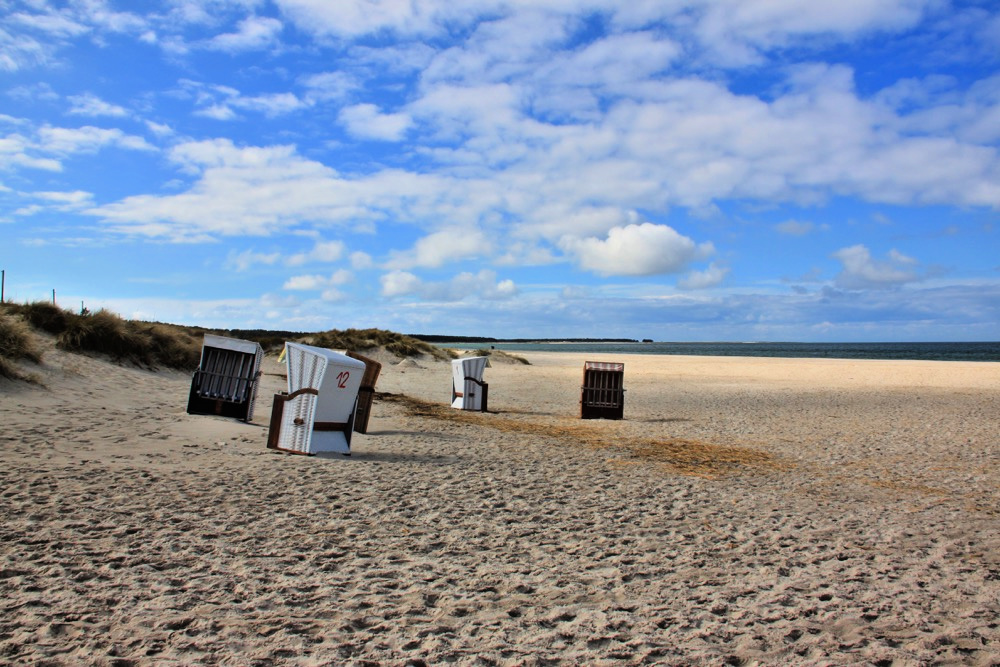
MUST DO IN AHLBECK:
- Heringdorfer Strand: Take a walk along the Heringdorfer Strand that stretches for miles with a good mix of cycle paths, parks, beaches, and a beautiful pier with an Italian restaurant where you can feast on some mouth-watering dishes with a glass of wine as you watch the world go by.
- Crossing The Border With Poland: Cross the border to Poland by taking a walk through the Europa Promenade, a structure that symbolizes the union between Poland and Germany. Sit on the beach and listen to the singing sand when dusk sets.
- Wolsgatsee Lake: Pack a picnic basket and take a boat out to the middle of the stunning Wolsgatsee Lake. If you are feeling up to it, perhaps explore the forest 100 meters away to find a smaller lake, Schwarzes Herz.
- Mellenthin Botanical Garden: Smell the flowers as you stroll around the colourful Mellenthin Botanical Garden which has 14 garden areas filled with 50,000 plants.
Recommended by Karolina of Lazy Travel Blog
Read Reviews for these Sights: Heringdorfer Strand | Mellenthin Botanical Garden
ROSTOCK
Located on the Baltic Coast of Germany, the Hanseatic town of Rostock is worth putting on your itinerary for northern Germany. Bombed heavily in World War II, the town has been largely restored to its medieval glory.
Rostock is a port on many Baltic cruise itineraries. But it also makes for the perfect day trip from Berlin or Hamburg. One day in Rostock will allow you to take in the top sights in this university town. But Rostock, and its seaside satellite resort Warnamunde, are also lovely laid-back places to relax for 2 or 3 days.
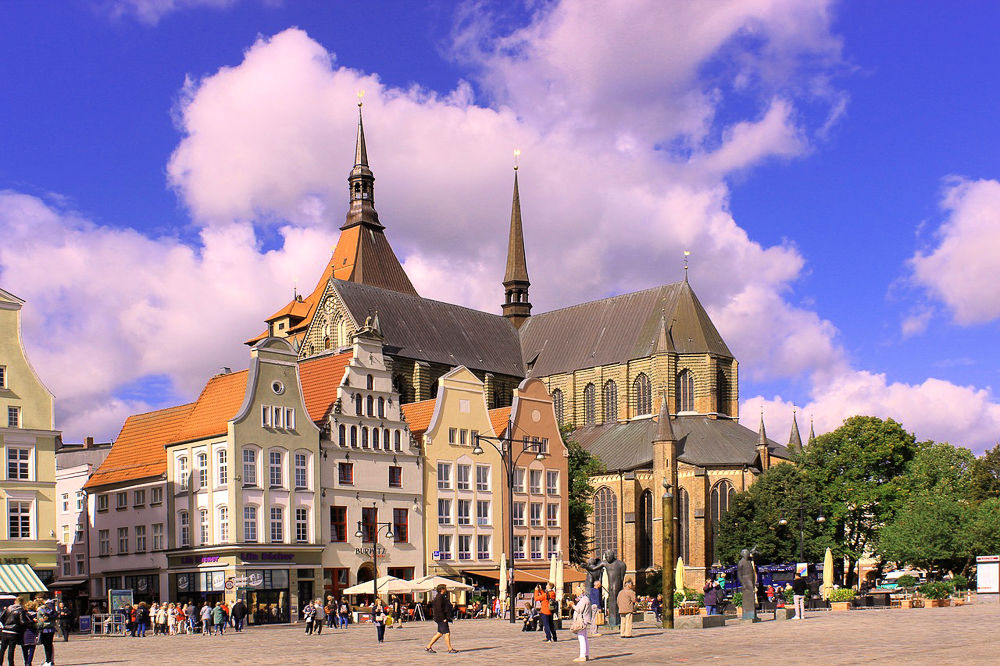
MUST DO IN ROSTOCK:
- Visit the historic Marienkirche: Right next to the town square, St. Mary’s Church is the largest of Rostock’s three gorgeous medieval churches still standing. It has a Brick Gothic exterior and an enormous tower. Inside, don’t miss the beautiful organ and the astronomical clock. The 15th-century clock features both time and a calendar. If you visit at noon, you can see the procession of the apostles at the top of the clock. It is simply stunning!
- People watch at University Square: Head to the University Square around lunchtime for some people watching while you eat. Rostock’s university is one of the oldest in Europe. The architecture of the buildings is beautiful, and the square, with its fountains and sculptures, and lots of nearby shopping, is a great place to chill for a bit.
- Walk around town: Rostock was very wealthy in Hanseatic times, and its wealthy merchants built a wall around the town for protection. There were several city gates in medieval times, and two of them are still standing. Walk around the town to admire the medieval facades, the churches, and the town gates.
Recommended by Dhara of Not About the Miles
Read Reviews for these Sights: Marienkirche
DRESDEN
Known as the “Florence of North” due to its splendid architecture and rich history, Dresden is the capital city of the German land of Saxony. Built on Elba river it was the royal residence for the Kings of Saxony and the family seat of Polish monarchs. It was a real jewel, but unfortunately, its baroque and rococo city centre was destroyed by Allied bombers during the Second World war.
The restoration work after the war managed to bring back some of the city’s lost charm. The Zwinger, Frauenkirche and the famous Semper Oper are just some of the buildings that were reconstructed after the war. Today Dresden is an educational and cultural centre of Germany and it offers its visitors many places to see.
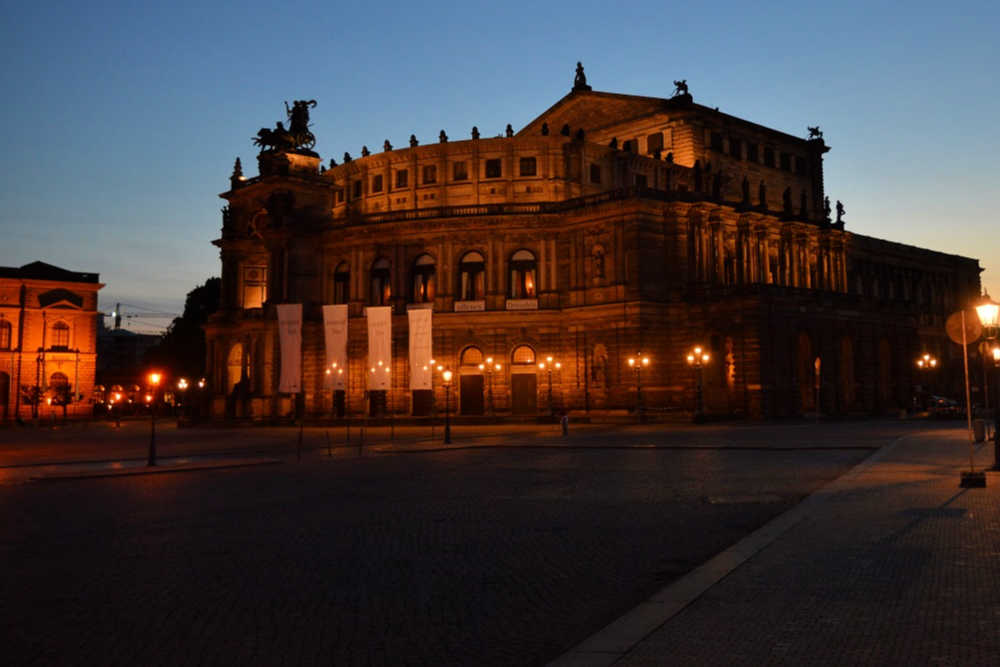
MUST DO IN DRESDEN:
- Zwinger Palace: Built in Baroque style, the palace used once as orangery and festival arena of the Dresden Court, hosts today the biggest porcelain collection in the world, a picture gallery and an impressive exposition of Mathematical and Physical Instruments.
- Frauenkirche: The symbol church in Dresden, Frauenkirche was destroyed during the second world war and remained in ruins for over 50 years. It was rebuilt between 1994 and 2005 and today it is again one of the most prominent buildings in the historical centre of Dresden.
- Green Vault Museum: Sort of like the newly popular art of supping, take a stab at punting. A true test of balance, give it a try yourself with your own boat and pole or pay for a uni student to take you for an informative tour.
Walking around the historical centre in Dresden you will find other buildings that will catch your eyes and, just for a moment, you won’t believe that once everything was ruin here!
Recommended by Carina of Another Milestone
Read Reviews for these Sights: Zwinger Palace | Frauenkirche | Green Vault Museum
LUBECK
The beautiful and culturally rich city of Lübeck sits at the edge of the Baltic Sea in the northern German state of Schleswig-Holstein. Constructed in the mid-12th century, the old town centre is a UNESCO World Heritage Site and is well known for its unique and exceptional Gothic Brick architecture. The iconic front gate, known as the Holstentor, was said to be built in the 15th century and was one of only two entrances into the stronghold.
Lübeck was known as the Queen of the Hanseatic League, the major confederation of merchants’ guild and market towns in northwestern and central Europe. Starting in the 14th century, Lübeck maintained a reputation as being the centre for maritime commerce up until the 16th century. Although heavily damaged during World War II, Lübeck residences, public monuments, and churches still manage to resemble their 15th and 16th-century origins thanks to careful reconstruction and restoration.
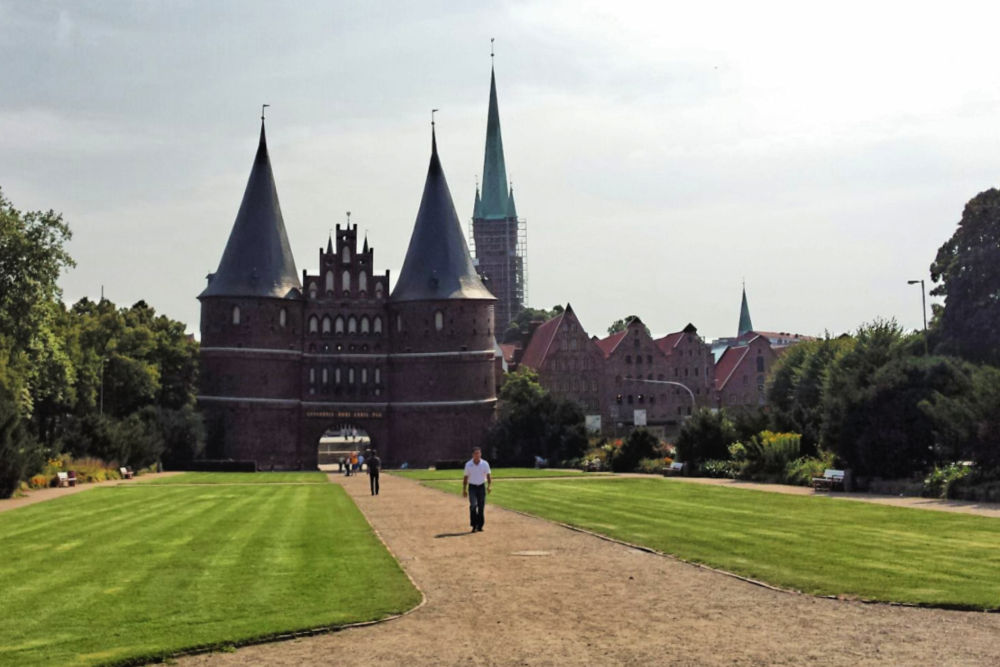
MUST DO IN LUBECK:
- Visit Niederegger and buy marzipan: Lübeck is famous for marzipan and local legend says that it was invented in this Medieval town. The Niederegger store has been open since 1806, selling some of the most exquisite and delicious marzipan you have ever tasted. Even if you’re not a fan of the almond and sugar creation, do yourself a favour and just peruse the aisles in the store.
- Tour the Holstentor: Step inside the most unique and imposing front gates. The Holstentor interior is actually a small museum with each level within dedicated to a different period of Lübeck’s history. Check out the weapons and armour from Medieval times!
- Wander the cobblestone streets: The old town section of Lübeck is an island and surrounded by tall gates. Throw out the guide book and wander around the streets, walking through history.
Recommended by Rachelle of Adventure is Never Far Away
Read Reviews for these Sights: Cafe Niederegger | Holstentor
WERNIGERODE
Wernigerode is a hidden gem, found at the foothills of the Harz region of Germany. A town of only 35,000 people, means it is fairly unknown to tourists outside of the country. This makes it a wonderful place to soak in the culture and history of the region quietly and at your own pace.
The medieval town is filled with colourful half-timbered houses, a unique 16th-century Gothic town hall (Rathaus) and a charming main square that is often home to a local market. The old town is compact and walkable, and I suggest spending at least one day exploring the little alleyways, that make this town so enchanting.
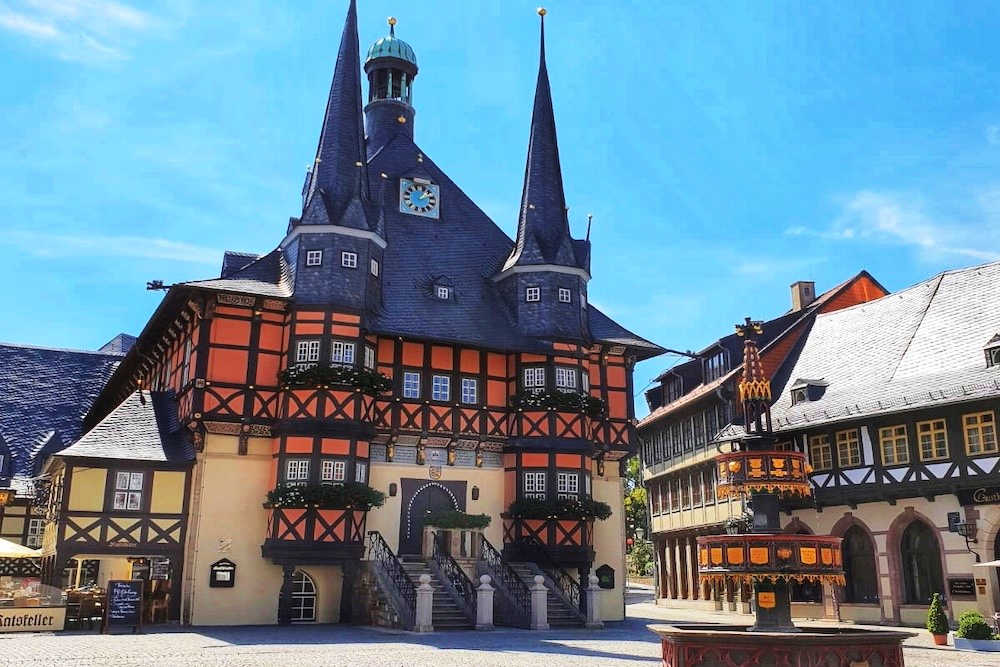
MUST DO IN WERNIGERODE:
- Visit Wernigerode Castle: a romantic 12th-century baroque castle that was once a medieval fortress. It towering 300ft above the town and offers panoramic views of the medieval city.
- Cross the longest pedestrian suspension bridge in the world: The Titan RT bridge stretches 458 meters across and is situated 100 meters above Germany’s highest reservoir, Rappbode Dam. It is just a bus ride away from Wernigerode, and if you want to get your heart pumping by you can zipline across or bungee jump off the bridge.
- Ascend Brocken Mountain: Wernigerode is the gateway to the Brocken, the highest and most famous mountain in the Harz. You can spend the day hiking up there (as I did) or take a steam train ride for 1hr 40min. At the top, there is a great view of the Harz area, as well as a hotel, restaurant, theatre, and botanical garden.
Recommended by Roshni of The Wanderlust Within
Read Reviews for these Sights: Wernigerode Castle | Brocken Mountain
BERLIN
Berlin was founded in the 13th-century and has played a role as the capital of various Kingdoms and Republics since then. It is probably most famous for the wall that divided the city after the end of World War II. Whilst the city is now undivided stretches of the wall can still be seen in many parts of the city, including the famous East Side Gallery where the Western side of the wall was covered in graffiti.
Today Berlin is a modern cosmopolitan city with plenty to appeal to tourists of all kinds. Whether you want to explore its history, visit its museums, admire its architecture or enjoy its nightlife, you’ll find something for everyone in the German Capital.
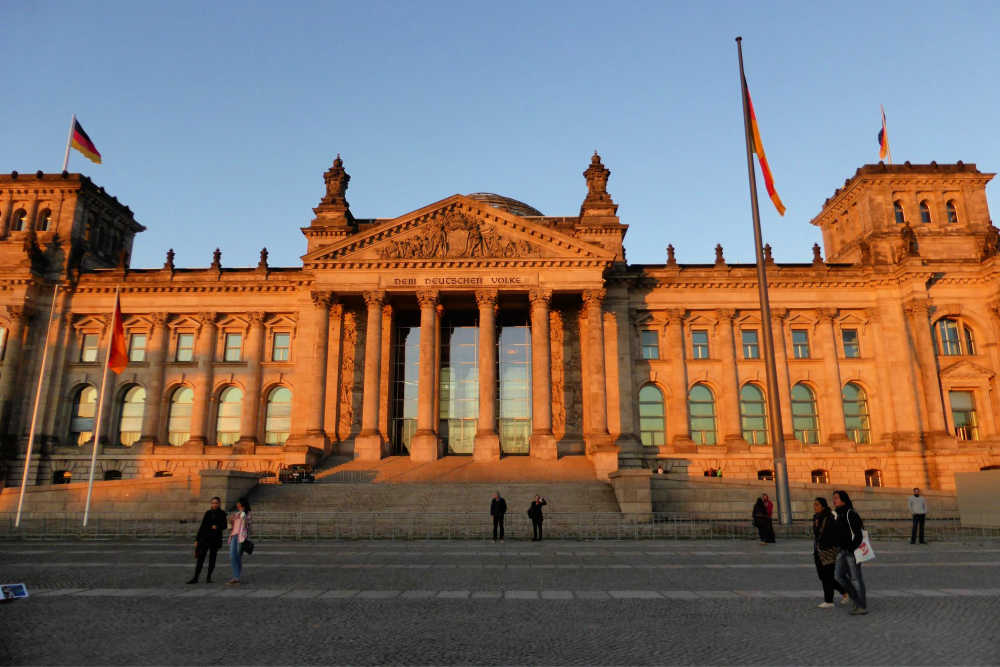
MUST DO IN BERLIN:
- Climb the Reichstag: The Reichstag is home to the German parliament, but is open to visitors who can go out onto the roof and climb the modern dome for views across Berlin and down onto the Brandenburg Gate. Tickets are free, but book in advance as they may not have any left on the day.
- Pay your respects at the Memorials: Berlin hosts many memorials to the horrors of World War II and the holocaust. The largest occupies an entire city block and remembers the six million Jewish victims, whilst others, such as the Sinti and Roma memorial are much smaller, they are all powerful in their own way. One we found particularly moving was Platform 17 at Grunewald station. Here the edge of the platform is marked for all the trains that left from there taking people to concentration and death camps.
- Explore Museum Island: Home to world-class museums as well as the Berliner Dom, you can easily spend a day here. From huge ancient artefacts such as the Ishtar Gate and Pergamon Altar to thousands of smaller exhibits including the famous bust of Nefertiti.
Read Reviews for these Sights: Reichstag | Jewish Memorial | Sinti and Roma Memorial | Platform 17 | Musuem Island | Berliner Dom
READ MORE: Want to spend a weekend in Berlin? Check out our weekend guide to help you plan your trip!
HAMBURG
The ‘Free and Hanseatic City of Hamburg’ to give it its formal title is best known as a port city despite being some 65 miles from the open sea. It is also famous for being the inspiration for the Hamburger, though Hamburg Steaks, as they were originally known, came without the bun that makes them such an easy fast food to eat nowadays.
The city’s other major claim to fame is that the Beatles played here many times at the start of their career. Three of the four clubs they played in most are still around in one form or another. The city’s love of music can be seen most clearly today with the 110-metre-high (361-foot) Elbphilharmonie concert hall.
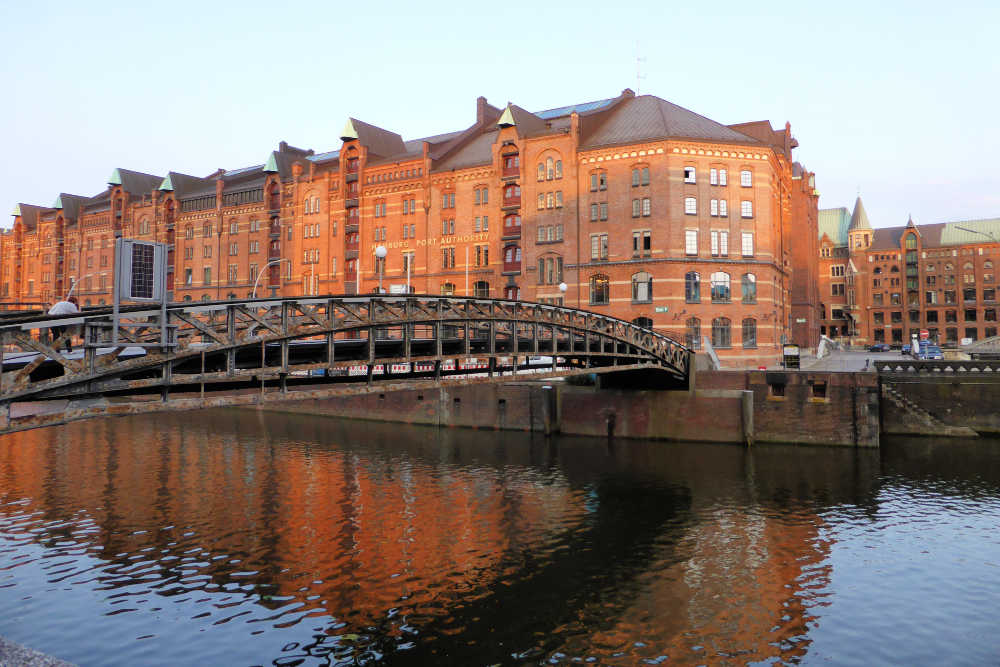
MUST DO IN HAMBURG:
- Wander around Speicherstadt: Speicherstadt translates as ‘City of Warehouses’ and is the largest warehouse complex in the world. It was originally built as a freeport in the River Elbe to avoid being part of the customs union when Hamburg became part of Germany. Today this impressive area houses multiple museums and is great place just to wander around. Its importance has been recognised by it receiving UNESCO World Heritage status.
- Visit Miniatur Wunderland: The World’s Largest Model Railway is located in one of the former port warehouses. Continuously growing, at the time of writing it was over about 1,500 m2 in size, with over 1,000 trains, 9,000 cars and 15 km of track. The site contains several distinct areas including cities like Hamburg and Venice, countries such as Italy and the USA and even an airport where 42 planes (and even the occasional space shuttle) come in to land, taxi and the take-off again!
- Explore the International Maritime Museum: Covering 3,000 years of maritime history, the International Maritime Museum is located in the oldest warehouse in Speicherstadt. Across nine ‘decks’ the museum encompasses thousands of artefacts including a copy of the first nautical atlas “Atlantis Majoris” from 1657.
Read Reviews for these Sights: Speicherstadt | Miniatur Wunderland | International Maritime Museum
LEIPZIG
The largest city in Saxony, Leipzig has been a major trading city since Roman times. Its location led to it being the terminus of Germany’s first long-distance railway which led to being a hub for rail traffic throughout central Europe.
After World War II, Leipzig ended up in East Germany and suffered a decline as a result of the oppressive regime. It played a major part in the events that lead to the collapse of the Iron Curtain and the subsequent reunification of Germany.
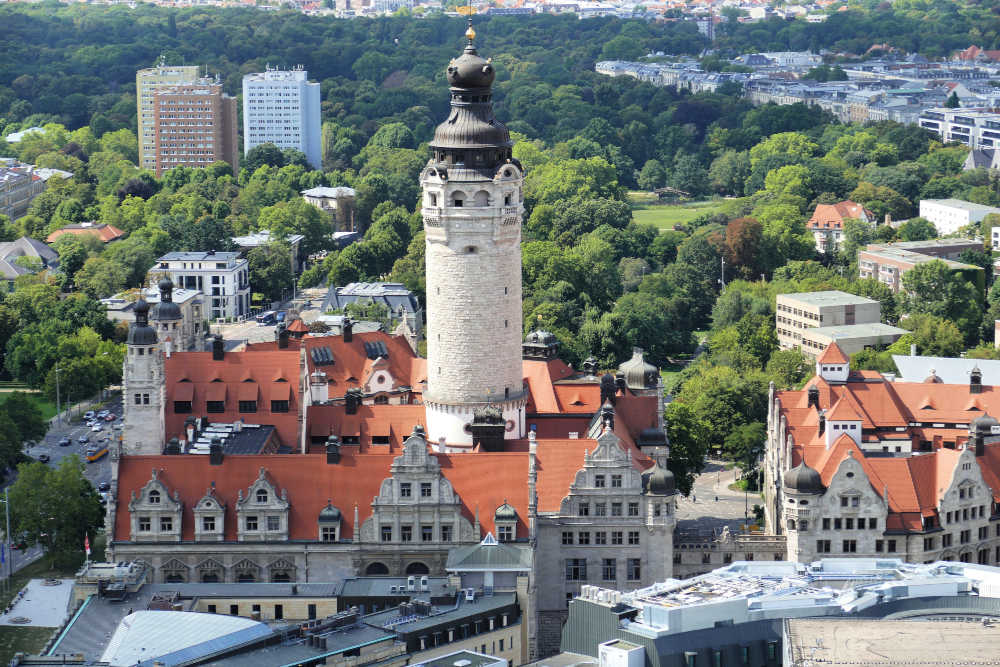
MUST DO IN LEIPZIG:
-
Climb the Völkerschlachtdenkmal: The Völkerschlachtdenkmal is a 91m high monument to one of Napolean’s final defeats. The battle of Leipzig saw over 600,000 soldiers fight, the largest battle in history at the time. You can climb the 500 steps to the viewing platform for expansive views across the city and beyond.
-
View the Leipzig Panometer: Formerly a gasometer, for holding gas for homes as part of the delivery network, the Leipzig Panometer has been converted to display Asisi’s Panoramas. Yadegar Asisi is an Austrian artist who grew up in Leipzig. Each of his panoramas is 30m high and 105m in circumference and is displayed on the interior of the gasometer.
-
Visit the Zeitgeschichtliches Forum: The Zeitgeschichtliches Forum is a museum dedicated to documenting what life was like in East Germany from 1949 until re-unification in 1990. Over 3,000 exhibits, including personal accounts, document what life was like under the repressive Socialist Unity Party regime.
Read Reviews for these Sights: Volkerschlachtdenkmal | Panometer | Zeitgeschichtliches Forum
Want to save this for later? Click the Pinterest button on the left for a pinnable image!
RESOURCES | PLAN YOUR TRIP TO GERMANY
To book flights, rental cars, accommodations, and activities for your trip, please check out our recommended travel providers, favourite apps and websites.
These are a few tours we would recommend for your trip to Northern and Eastern Germany.
Some of the links in the post above are affiliate links. This means if you click on the link and purchase the item, we will receive an affiliate commission but this does not affect the price to you. Please read our full disclosure policy here.


